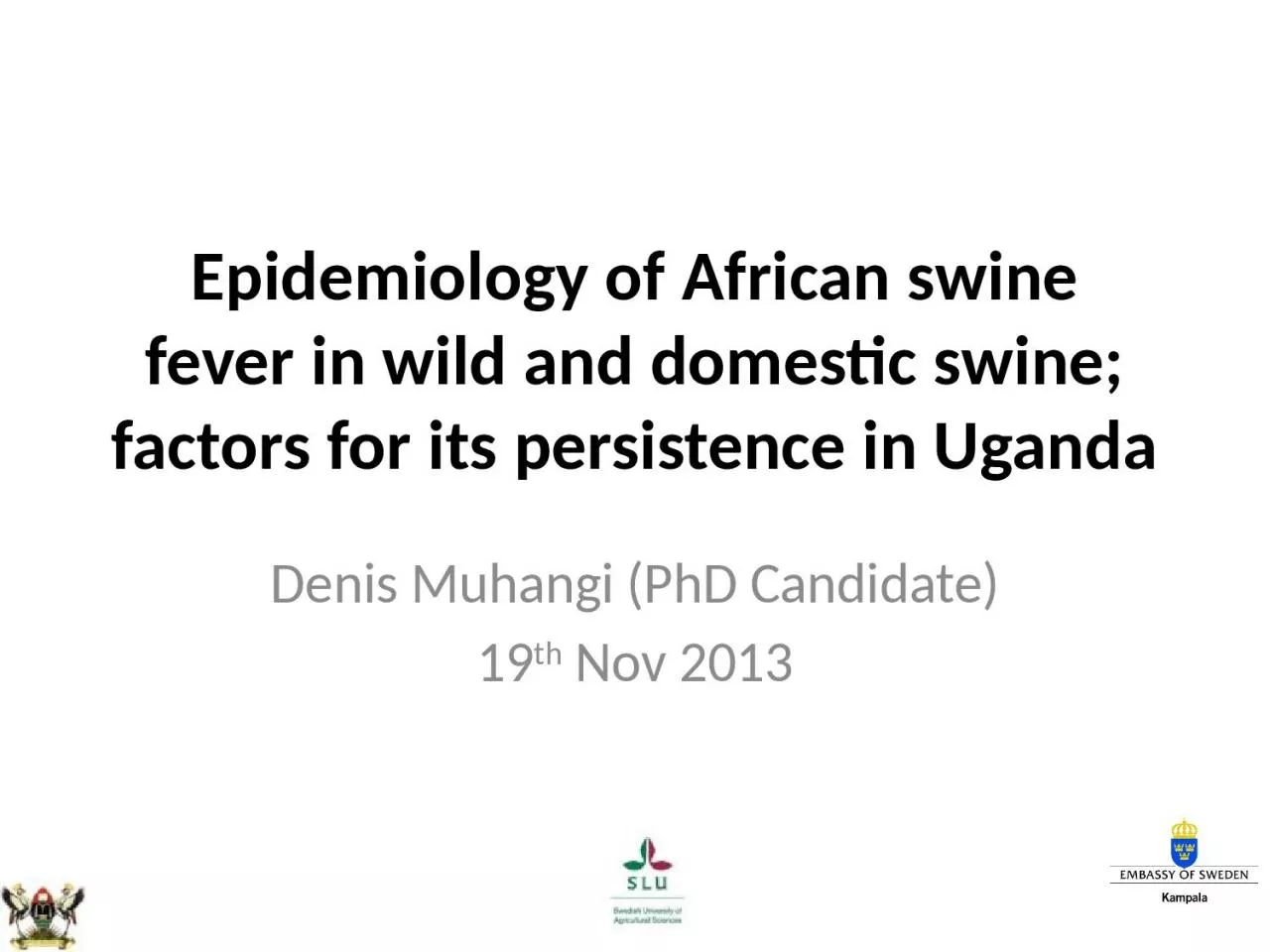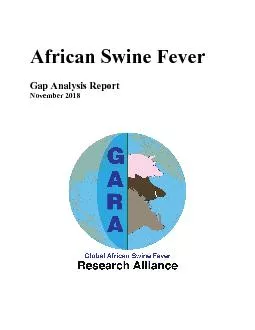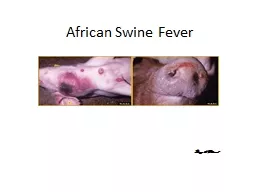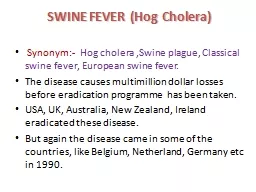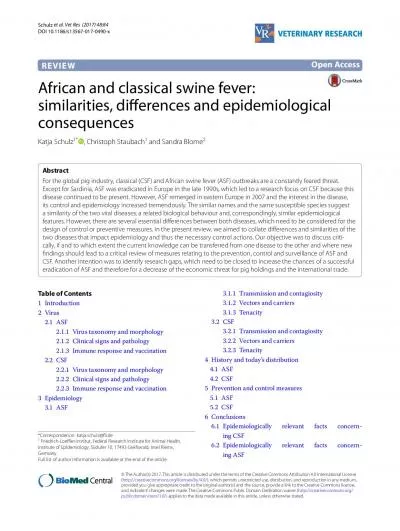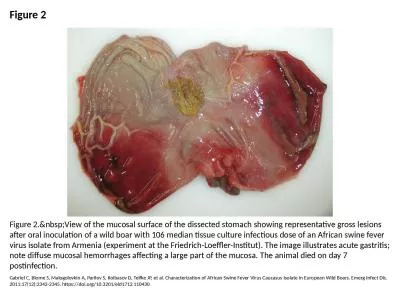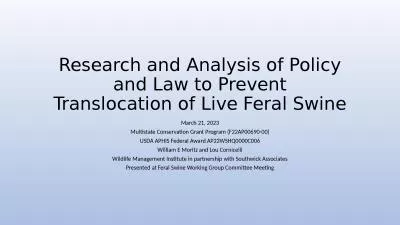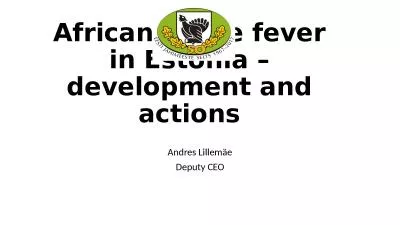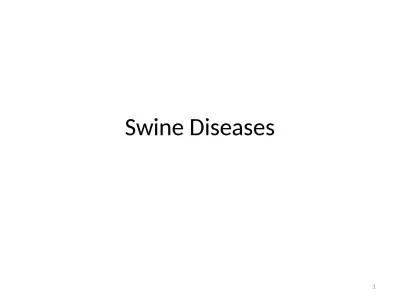PPT-Epidemiology of African swine fever in wild and domestic swine; factors for its persistence
Author : priscilla | Published Date : 2023-11-20
Denis Muhangi PhD Candidate 19 th Nov 2013 African swine fever ASF overview large DNA virus genus Asfivirus family Asfarviridae Up to 22 genotypes OIE listed viral
Presentation Embed Code
Download Presentation
Download Presentation The PPT/PDF document "Epidemiology of African swine fever in w..." is the property of its rightful owner. Permission is granted to download and print the materials on this website for personal, non-commercial use only, and to display it on your personal computer provided you do not modify the materials and that you retain all copyright notices contained in the materials. By downloading content from our website, you accept the terms of this agreement.
Epidemiology of African swine fever in wild and domestic swine; factors for its persistence: Transcript
Denis Muhangi PhD Candidate 19 th Nov 2013 African swine fever ASF overview large DNA virus genus Asfivirus family Asfarviridae Up to 22 genotypes OIE listed viral disease Acute highly contagious in domestic pigs. The African swine fever virus ASFV is highly contagious and can spread very rapidly in pig populations by direct or indirect contact This virus can persist for long periods in pig products and the enviro nment It can also become endemic in feral or All age groups are equally susceptible With high virulence forms of the virus ASF is characterized by high fever loss of appetite haemorrhages in the skin and internal organs and death in 210 days on average Mortality rates may be as high as 100 The Domestic Builder Unlimited DBU Domestic builders registered in the DBU class may personally carry out or manage or arrange for subcontractors to carry out all components of domestic building work Domestic Builder Manager DBM Domestic builders regi There are lots of different names for these dogs, and here are some of them. :. African Wild Dog. , African Hunting Dog, Cape Hunting Dog, Painted Dog, Painted Wolf, Painted Hunting Dog, Spotted Dog, and Ornate Wolf. . Robert Reichardt. October 12, 2012. Admissions and Transfer Group. Department of Higher Education, Denver CO. Overview. Background, sample and limitations. CSAP Analysis. Does . the CSAP predict whether a student will attend a 4-year or 2-year institution?. 2 The Global African Swine Fever Research Alliance (GARA) aims to expand ASF research collaborations worldwide and maximize the use of resources and expertise to achieve its five strategic goals: 1. T Walrond. Overview. Organism. Economic Impact. Epidemiology. Transmission. Prevention. Actions to Take. Species Affected. Domestic pigs. Feral swine. Wild pigs. Eurasian wild boars. Warthogs (reservoir). . Synonym:- . Hog cholera ,Swine plague, Classical swine fever, European swine fever.. The disease causes multimillion dollar losses before eradication programme has been taken.. USA, UK, Australia, New Zealand, Ireland eradicated these disease.. IntroductionSimilar names suggest similar disease characteristics for African and classical swine fever (ASF and CSF). In fact, ASF was even thought to be caused by the same virus as CSF [] before Mon Rahimi P, Sohrabi A, Ashrafihelan J, Edalat R, Alamdari M, Masoudi M, et al. Emergence of African Swine Fever Virus, Northwestern Iran. Emerg Infect Dis. 2010;16(12):1946-1948. https://doi.org/10.3201/eid1612.100378. Gabriel C, Blome S, Malogolovkin A, Parilov S, Kolbasov D, Teifke JP, et al. Characterization of African Swine Fever Virus Caucasus Isolate in European Wild Boars. Emerg Infect Dis. 2011;17(12):2342-2345. https://doi.org/10.3201/eid1712.110430. March 21, 2023. Multistate Conservation Grant Program (F22AP00690-00). USDA APHIS Federal Award AP22WSHQ0000C006. William E Moritz and Lou Cornicelli. Wildlife Management Institute in partnership with Southwick Associates. Estonia – . development. and . actions. Andres . Lillemäe. Deputy . CEO. ESTONIA. . The area of Estonia is 45,227 . m. 2. T. he population is 1,3 . millio. n . people. . There. are . about. 15 000 . Diseases of Swine, 10. th. ed., 2012; Straw, B., et.al.. American Association of Swine Veterinarians. Journal of Swine Health and Production. AASV.org website; disease modules. Swine Disease Manual, 4rd edition 2009; Neumann, Ramirez, Schwartz.
Download Document
Here is the link to download the presentation.
"Epidemiology of African swine fever in wild and domestic swine; factors for its persistence"The content belongs to its owner. You may download and print it for personal use, without modification, and keep all copyright notices. By downloading, you agree to these terms.
Related Documents

